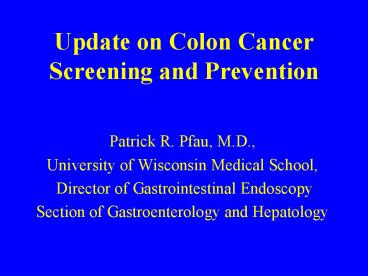Update on Colon Cancer Screening and Prevention PowerPoint PPT Presentation
1 / 41
Title: Update on Colon Cancer Screening and Prevention
1
Update on Colon Cancer Screening and Prevention
- Patrick R. Pfau, M.D.,
- University of Wisconsin Medical School,
- Director of Gastrointestinal Endoscopy
- Section of Gastroenterology and Hepatology
2
Colorectal Cancer
- Lifetime incidence 5
- 90 of cases occur after age 50
- One-third of patients with colorectal cancer die
from the disease - Only approximately 50 of patients are screened
for colorectal cancer - Colorectal cancer is a preventable disease
3
(No Transcript)
4
(No Transcript)
5
(No Transcript)
6
(No Transcript)
7
Colon polyps
- Two-thirds of polyps are adenomas (dysplasia)
- Adenoma prevalence 25 at age 50 and 50 by age
70 - Risk of cancer increases with polyp size, number,
and histology - The polyp examined is representative of the
individuals propensity to form polyps and cancer
8
Adherence Rates Cancer Screening
- U.S. Adherence
Rates - Breast Cancer 69
- Cervical Cancer 86
- Prostate Cancer 75
- Colorectal Cancer 45 63
- Seeff Cancer 2002952211-22
- Sirovich JAMA 20032891414-20
9
Colon Cancer Screening When to Begin ?
- Average risk begin at age 50
- Family risk factors
- Primary degree relative doubles risk
- Begin screening at age 40 or 10 years earlier
than diagnosis of relative - Colon cancer syndromes (5-10 of colon CA)
- Hereditary non-polyposis colorectal cancer
(HNPCC) - Colonoscopy every 1-2 years beginning at age
20-25 - Familial Adenomatous Polyposis (FAP)
10
CRC Screening Guidelines- Average Risk
- GI Consortium
- Annual FOBT
- Flex sig every 5 yrs
- Combination of above
- DCBE every 5 years
- Colonoscopy every 10 years (preferred option
ACG) - Winawer Gastroenterology 2003124544-560
- American Cancer Society
- Recommendations now identical to the GI
consortium - Smith CA Cancer J Clin 20045441-52
11
(No Transcript)
12
Quantitative immunochemical FOBT
- Improved detection of hemoglobin as compared to
guaic based FOBT tests - Immunochemical FOBT testing uses antibodies to
human globin expressed in colorectal bleeding. - 94 sensitivity for cancers and 67 for
advanced adenomas with approximate 90
sensitivity in high risk individuals (Ann Int Med
2007) - Has not yet been tested in asymptomatic average
risk patients
13
A word about the digital rectal exam
14
(No Transcript)
15
(No Transcript)
16
Sigmoidoscopy Weaknesses
- 20-30 of proximal advanced adenomas are missed
with sigmoidoscopy - Sigmoidoscopy particularly poor in women missing
65 of advanced polyps as opposed to colonoscopy
(NEJM 2005) - Would you ever mammogram one breast ?
17
(No Transcript)
18
(No Transcript)
19
Screening Colonoscopy
- Two large cohort studies (Winawer, et al, NEJM
1993 and Citarda, et al Gut 2001) have
demonstrated significant reductions in colon
cancer incidence if colonoscopy with polypectomy
are performed - FOBT and sigmoidoscopy that lead to colonoscopy
with polypectomy have been shown to significantly
reduce colorectal cancer mortality
20
(No Transcript)
21
(No Transcript)
22
(No Transcript)
23
Screening colonoscopy
- Combines the most complete examination of the
colon with the direct therapy of removing
dysplastic polyps - The role of polyps as a precursor to cancer
provides the rationale for endoscopic screening
illustrated by the benefit of adenoma removal by
polypectomy at the time of colonoscopy
24
Novel and Emerging Advances in Colorectal Cancer
Screening
- CT colonography/Virtual colonoscopy
- Fecal DNA analysis
- Capsule endoscopy
25
CT colonography/Virtual colonoscopy
- Computed tomography procedure that uses helical,
multiple thin section images along with
specialized computer programming to provide
three-dimensional and two-dimensional images of
the colon
26
(No Transcript)
27
Virtual Colonoscopy Quiz How many insurance
carriers in the United States and internationally
have approved CT colonography for colon cancer
screening ?
- Physicians Plus
- Unity
- Group Health
28
Virtual Colonoscopy - Sensitivity
29
Per Patient Analysis of Polyp Detection at UW
30
Advanced Adenoma Comparison
31
Adenoma Comparison
32
(No Transcript)
33
Can you tell the difference between these polyps ?
34
(No Transcript)
35
Remember there is a person attached to every polyp
36
Fecal DNA Analysis
- Colorectal cancer is a disease in which many DNA
mutations associated with carcinogenesis have
been characterized - Stool DNA is stable, shed continuously and
through amplification tests can be detected in
minute amounts - Most studied stool test for DNA mutations is a
multicomponent test that targets point mutations
at 15 hot spots on K-ras, APC, p53, Bat-26, and
long DNA
37
Fecal DNA Analysis
- Alquist, et al. Gastroenterology 2000 studied
patients with colon cancers, large adenomas, and
normal colons - Sensitivity of 91 for colon cancer, 82 for
large adenomas and a specificity of 93 - Imperiale, et al. NEJM 2004 studied patients in a
screening population - Poor sensitivity for invasive cancers (52) and
advanced polyps (15)
38
M2A Capsule Endoscope
- M2A captures images at 2 fps
- More than 50,000 images are taken
- Field of view 140º
- Min. detectable object Less than 0.1 mm
39
Mouth to Cecum
Multiple telangiectasia on a gastric fold
Teeth
Epiglottis
Ileocecal valve
Wall of right colon
Small Intestine
40
Summary Colon Cancer Screening
- FOBT, barium enema, sigmoidoscopy
- All recommended but all with significant
weaknesses - Will iFOBT make a come back ?
- Screening Colonoscopy
- Standard of care Diagnosis along with therapy
- CT colonography
- Here today Further verification using one
technology in multicenter study and more
importantly how CT colongraphy will work with
standard colonoscopy - Fecal DNA analysis and Capsule Endoscopy
- Here tomorrow Further refinement and technical
improvements needed
41
- Screen your patient PCP most important
physician in colon cancer

